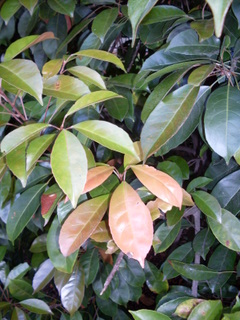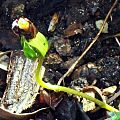Eumundi quandong facts for kids
Quick facts for kids Eumundi quandong |
|
|---|---|
 |
|
| Elaeocarpus eumundi - new growth | |
| Scientific classification | |
| Genus: |
Elaeocarpus
|
| Species: |
eumundi
|
The Elaeocarpus eumundi, often called the Eumundi quandong or smooth-leaved quandong, is a type of flowering plant. It belongs to the Elaeocarpaceae family and grows only in north-eastern Australia. This tree is medium-sized and has leaves shaped like eggs or spears. It produces cream-colored flowers in clusters and bright blue fruits. You can find it growing naturally in rainforests, from the Cape York Peninsula in Queensland down to north-eastern New South Wales.
Contents
What the Eumundi Quandong Looks Like
The Eumundi quandong is a tree that usually grows between 12 and 25 meters tall. That's about as tall as a four to eight-story building! It has bark that looks like fibers, and sometimes its trunk has wide, flat buttress roots at the bottom. These roots help the tree stay stable.
Its leaves often grow in bunches near the ends of the branches. They are shaped like an oval or a spear, wider at one end and narrower at the other. Each leaf is about 6 to 13 centimeters long and 2 to 4 centimeters wide. They grow on a small stem called a petiole, which is about 1 to 5 centimeters long.
Sometimes, the leaves have small teeth along their edges, especially near the tip. A main vein stands out on the top of the leaf. When the leaves get old, they turn yellow instead of red, which is a unique feature.
Flowers and Fruit
The flowers of the Eumundi quandong grow in groups of up to eight. Each flower hangs on a short, hairy stalk called a pedicel, which is about 6 to 8 millimeters long.
Each flower has five narrow, triangle-shaped parts called sepals, which are about 9 to 9.5 millimeters long. It also has five cream-colored petals, which can be up to 11 millimeters long. The tip of each petal is divided into many small, fringe-like parts. Inside the flower, there are between 24 and 30 stamens, which are the parts that produce pollen.
These trees usually flower from November to December. After flowering, they produce a blue, oval-shaped fruit. This fruit is a type of drupe, similar to a plum or a cherry, and it's about 15 millimeters long.
How the Eumundi Quandong Got Its Name
The Eumundi quandong was officially described and named in 1894 by a scientist named Frederick Manson Bailey. He wrote about it in a publication called Proceedings of the Royal Society of Queensland.
Bailey chose the specific name eumundi because, at the time, he thought the tree was only found in the Eumundi area of Queensland. This is how many plants get their names – from the place where they are first discovered!
Where the Eumundi Quandong Grows
This quandong tree is found in many rainforests across Australia. You can see it in the Cape York Peninsula and other parts of north-eastern and central-eastern Queensland. It grows in different types of places, sometimes at high altitudes, up to 1000 meters above sea level.
It's not as common in New South Wales, but you can still find it there. For example, it grows north of the Whian Whian State Conservation Area.
Uses of the Eumundi Quandong
Use in Gardens
The Eumundi quandong is a great choice for an ornamental tree in gardens and parks. This means it's planted because it looks beautiful. Its flowers attract birds that feed on nectar, and its fruits are a tasty treat for birds that eat seeds.
Use as Food
The fruit of the Eumundi quandong is known to be juicy and quite tart or acidic. While it's not a common fruit you'd find in a grocery store, some people enjoy its unique flavor.
Gallery







